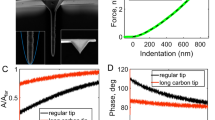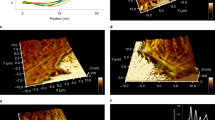Abstract
The nanomechanical properties of living cells, such as their surface elastic response and adhesion, have important roles in cellular processes such as morphogenesis1, mechano-transduction2, focal adhesion3, motility4,5, metastasis6 and drug delivery7,8,9,10. Techniques based on quasi-static atomic force microscopy techniques11,12,13,14,15,16,17 can map these properties, but they lack the spatial and temporal resolution that is needed to observe many of the relevant details. Here, we present a dynamic atomic force microscopy18,19,20,21,22,23,24,25,26,27,28 method to map quantitatively the nanomechanical properties of live cells with a throughput (measured in pixels/minute) that is ∼10–1,000 times higher than that achieved with quasi-static atomic force microscopy techniques. The local properties of a cell are derived from the 0th, 1st and 2nd harmonic components of the Fourier spectrum of the AFM cantilevers interacting with the cell surface. Local stiffness, stiffness gradient and the viscoelastic dissipation of live Escherichia coli bacteria, rat fibroblasts and human red blood cells were all mapped in buffer solutions. Our method is compatible with commercial atomic force microscopes and could be used to analyse mechanical changes in tumours, cells and biofilm formation with sub-10 nm detail.
This is a preview of subscription content, access via your institution
Access options
Subscribe to this journal
Receive 12 print issues and online access
$259.00 per year
only $21.58 per issue
Buy this article
- Purchase on Springer Link
- Instant access to full article PDF
Prices may be subject to local taxes which are calculated during checkout





Similar content being viewed by others
References
Nelson, C. M. et al. Emergent patterns of growth controlled by multi-cellular form and mechanics. Proc. Natl Acad. Sci USA 102, 11597 (2005).
Ingber, D. E. Tensegrity: the architectural basis of cellular mechanotransduction. Annu. Rev. Physiol. 59, 575–599 (1997).
Tan, J. L. et al. Cells lying on a bed of microneedles: an approach to isolate mechanical force. Proc. Natl Acad. Sci. USA 100, 1484–1489 (2003).
Dembo, M. & Wang, Y. L. Stresses at the cell-to-substrate interface during locomotion of fibroblasts. Biophys. J. 76, 2307–2316 (1999).
DuRoure, O. et al. Force mapping in epithelial cell migration. Proc. Natl Acad. Sci. USA 102, 2390–2395 (2005).
Suresh, S. Biomechanics and biophysics of cancer cells. Acta Biomater. 3, 413–438 (2007).
Palm, K., Luthman, K., Ungell, A. L., Strandlund, G. & Artursson, P. Correlation of drug absorption with molecular surface properties. J. Pharm. Sci. 85, 32–39 (1996).
Breukink, E. et al. Use of the cell wall precursor lipid II by a pore-forming peptide antibiotic. Science 286, 2361–2364 (1999).
Fantner, G. E., Barbero, R. J., Gray, D. S. & Belcher, A. M. Kinetics of antimicrobial peptide activity measured on individual bacterial cells using high-speed atomic force microscopy. Nature Nanotech. 5, 280–285 (2010).
Rotsch, C. & Radmacher, M. Drug-induced changes of cytoskeletal structure and mechanics in fibroblasts: an atomic force microscopy study. Biophys. J. 78, 520–535 (2000).
Van Vliet, K. J., Bao, G. & Suresh, S. The biomechanics toolbox: experimental approaches to living cells and biomolecules. Acta Mater. 51, 5881–5905 (2003).
Cross, S. E., Jin, Y. S., Rao, J. & Gimzewski, J. K. Nanomechanical analysis of cells from cancer patients. Nature Nanotech. 2, 780–783 (2007).
Iyer, S., Gaikwad, R. M., Subba-Rao, V., Woodworth, C. D. & Sokolov, I. Atomic force microscopy detects differences in the surface brush of normal and cancerous cells. Nature Nanotech. 4, 389–393 (2009).
Radmacher, M., Fritz, M., Kacher, C. M., Cleveland, J. P. & Hansma, P. K. Measuring the viscoelastic properties of human platelets with the atomic force microscope. Biophys. J. 70, 556–567 (1996).
Matzke, R., Jacobson, K. & Radmacher, M. Direct, high-resolution measurement of furrow stiffening during division of adherent cells. Nature Cell Biol. 3, 607–610 (2001).
Arnoldi, M. et al. Bacterial turgor pressure can be measured by atomic force microscopy. Phys. Rev. E 62, 1034–1044 (2000).
Hassan, E. A. et al. Relative microelastic mapping of living cells by atomic force microscopy. Biophys. J. 74, 1564–1578 (1998).
Melcher, J. et al. Origins of phase contrast in the atomic force microscope in liquids. Proc. Natl Acad. Sci. USA 106, 13655–13660 (2009).
Van Noort, S. J. T., Willemsen, O. H., van der Werf, K. O., de Grooth, B. G. & Greve, J. Mapping electrostatic forces using higher harmonics tapping mode atomic force microscopy in liquid. Langmuir 15, 7101 (1999).
Preiner, J., Tang, J. L., Patsushenko, V. & Hinterdorfer, P. Higher harmonic atomic force microscopy: imaging of biological membranes in liquid. Phys. Rev. Lett. 99, 046102 (2007).
Dulebo, A. et al. Second harmonic atomic force microscopy imaging of live and fixed mammalian cells. Ultramicroscopy 109, 1056 (2009).
Turner, R. D., Kirkham, J., Devine, D. & Thomson, N. H. Second harmonic atomic force microscopy of living Staphylococcus aureus bacteria. Appl. Phys. Lett. 94, 043901 (2009).
Xu, X., Melcher, J., Reifenberger, R. & Raman, A. Compositional contrast of soft biological materials in liquids using the momentary excitation of higher eigenmodes. Phys. Rev. Lett. 102, 060801 (2009).
Martínez, N. F. et al. Bimodal atomic force microscopy imaging of isolated antibodies in air and liquids. Nanotechnology 19, 384011 (2008).
Platz, D., Tholen, E. A., Pesen, D. & Haviland, D. B. Intermodulation atomic force microscopy. Appl. Phys. Lett. 92, 153106 (2008).
Tetard, L., Passian, A. & Thundat, T. New modes for sub-surface atomic force microscopy through nanomechanical coupling. Nature Nanotech. 5, 105–109 (2010).
Tetard, L. et al. Imaging nanoparticles in cells by nanomechanical holography. Nature Nanotech. 3, 501–505 (2008).
Dong, M. D., Husale, S. & Sahin, O. Determination of protein structural flexibility by microsecond force spectroscopy. Nature Nanotech. 4, 514–517 (2009).
Vadillo-Rodriguez, V. & Dutcher, J. R. Dynamic viscoelastic behavior of individual gram negative bacterial cells. Soft Matter 5, 5012–5019 (2009).
San Paulo, A. & García, R. Tip sample forces, amplitude and energy dissipation, in amplitude modulation (tapping mode) force microscopy. Phys. Rev. B 64, 193411 (2001).
Plodinec, M. et al. The nanomechanical properties of rat fibroblasts are modulated by interfering with the vimentin intermediate filament system. J. Struct. Biol. 174, 476–484 (2011).
Alsteen, D. et al. Structure, cell wall elasticity and polysaccharide properties of living yeast cells, as probed by AFM. Nanotechnology 19, 384005 (2008).
Dupres, V. et al. Nanoscale mapping and functional analysis of individual adhesins on living bacteria. Nature Methods 2, 515–521 (2005).
Heinz, W. F. & Hoh, J. H. Spatially resolved force spectroscopy of biological surfaces using the atomic force microscope. Trends Biotechnol. 7799, 143–150 (1999).
Acknowledgements
A.R. acknowledges financial support from the National Science Foundation (grant no. CMMI 0927648; programme manager, E. Misawa) and the Keeley visiting fellowship (awarded by Wadham Collage, University of Oxford) to support his stay at the University of Oxford. S.C. and A.R. also acknowledge financial support from the Engineering and Physical Sciences Research Council (EPSRC, grant no. EPSRC-EP/H043659/1). S.C. also acknowledges support from the Research Councils UK and Oxford Martin School.
Author information
Authors and Affiliations
Contributions
A.R. and S.T. are lead authors and contributed equally to this work. A.R. discovered the important experimental channels for material contrast. S.T., A.C., A.S, A.R., E.N. and M.S. developed experimental protocols for sample preparation. A.R., S.T. and S.C. conceived and designed the experiments. A.R. developed the theory and A.C. performed the numerical simulations and developed the code to implement the theory on the acquired AFM images. A.R., A.C., A.S. and S.T. performed the experiments. A.R. and S.T. co-wrote the paper. All authors discussed the results and commented on the manuscript.
Corresponding author
Ethics declarations
Competing interests
The authors declare no competing financial interests.
Supplementary information
Supplementary information
Supplementary information (PDF 2151 kb)
Rights and permissions
About this article
Cite this article
Raman, A., Trigueros, S., Cartagena, A. et al. Mapping nanomechanical properties of live cells using multi-harmonic atomic force microscopy. Nature Nanotech 6, 809–814 (2011). https://doi.org/10.1038/nnano.2011.186
Received:
Accepted:
Published:
Issue Date:
DOI: https://doi.org/10.1038/nnano.2011.186
This article is cited by
-
Surveying membrane landscapes: a new look at the bacterial cell surface
Nature Reviews Microbiology (2023)
-
Viscoelastic parameterization of human skin cells characterize material behavior at multiple timescales
Communications Biology (2022)
-
3D nanomechanical mapping of subcellular and sub-nuclear structures of living cells by multi-harmonic AFM with long-tip microcantilevers
Scientific Reports (2022)
-
System identification of biological cells by atomic force microscopy
International Journal on Interactive Design and Manufacturing (IJIDeM) (2022)
-
Activating internal resonance in a microelectromechanical system by inducing impacts
Nonlinear Dynamics (2022)



